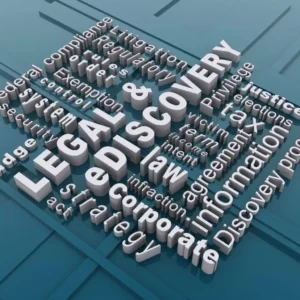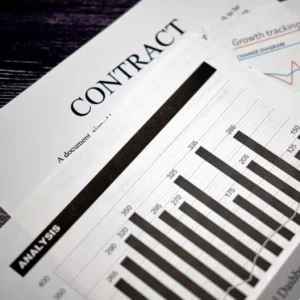
Revolutionizing Evidence Compilation
AI in Courtroom Support
The courtroom, a bastion of tradition, is undergoing a digital renaissance. At the forefront of this transformation is AI in courtroom support. From the meticulous process of evidence compilation to the intricate dance of jury selection, artificial intelligence is casting its innovative net, revolutionizing age-old practices.
As we stand on the brink of this new era, this article explores the depths of AI’s intervention in legal proceedings. We unveil groundbreaking changes from machine learning for legal strategy formulation to the unseen benefits of AI-enhanced litigation data visualization.
Prepare to journey through the transformative landscape where law meets technology.
Table of Contents
Streamlining Evidence Compilation
The advent of AI in courtroom support has ushered in groundbreaking changes, most notably in evidence compilation. Before AI’s integration, legal professionals painstakingly collected, organized and analyzed vast troves of evidence.
Today, using AI in evidence gathering and organization, the process has transformed into a streamlined, efficient endeavour. Machine learning tools, another facet of AI, contribute significantly to legal strategy formulation. They sift through data, identifying patterns that might escape human scrutiny.
But that’s not all. The historically tedious and time-consuming pre-trial phase now sees the integration of AI tools for pre-trial preparations. These tools assist in readying witnesses, with AI tools for witness preparation at the forefront. With such advancements, accuracy gets a boost, especially with AI-enhanced litigation data visualization and AI in legal transcription recording. These tools ensure that every shred of evidence and statement is captured precisely.
As we navigate this digital transition, it becomes evident that AI isn’t just a tool; it’s a game-changer. If AI can revolutionize evidence compilation to this extent, How will it reshape other facets of courtroom procedures and strategies?
Crafting Potent Legal Strategies with AI
In the intricate world of legalities, strategy is everything. Enter AI in courtroom support, a beacon reshaping the entire terrain. One pivotal area it’s transforming is legal strategy formulation. Gone are the days of attorneys relying solely on intuition and experience. Now, with the power of machine learning, patterns in past court cases, opponent behaviours, and even jury reactions are analyzed to create informed legal strategies.
Furthermore, predictive analytics in jury selection is another ace up the AI sleeve. AI can predict their inclinations by assessing potential jurors’ backgrounds and responses, ensuring a more favourable jury composition. Coupled with AI-enhanced litigation data visualization, lawyers can quickly grasp complex data patterns, making case analysis more intuitive.
The efficiency continues beyond there. Preparing witnesses has always been a pivotal yet unpredictable, part of any trial. With AI tools for witness preparation, the unpredictability is reduced, making testimonies more consistent and compelling.
With AI sculpting powerful courtroom strategies and simplifying pre-trial tasks like AI tools for pre-trial preparations, what other areas of legal practice might we see it redefine? How deep will its influence permeate?
Enhancing Witness Readiness with AI Tools
Witness testimony can turn the tide in any legal battle. As AI in courtroom support gains traction, its tools uniquely position themselves to revamp witness preparation. Traditional methods, while effective, had room for enhancement, and AI fills that gap effortlessly. With the adoption of AI tools for witness preparation, briefing witnesses have seen vast improvements in consistency and accuracy.
Imagine integrating AI in evidence gathering and organization. Witnesses can be presented with well-organized facts, dates, and event sequences, aiding their recall. Further, machine learning for legal strategy formulation can predict potential cross-examination questions, prepping the witness for what’s to come.
Moreover, AI-enhanced litigation data visualization provides visual cues that can significantly assist witnesses in understanding intricate details and timelines. Their ability to recollect and articulate events becomes substantially straightforward.
Simultaneously, AI tools for pre-trial preparations ensure that all facets of a trial, including witness preparation, are synchronized and optimized. But as AI revolutionizes this space, a burning question emerges: If AI can streamline witness readiness to such an extent, how might it evolve other fundamental courtroom processes?
Making Informed Choices in Jury Selection
Jury selection, a critical phase in litigation, has met its digital matchmaker: AI in courtroom support. Predictive analytics in jury selection is proving indispensable with the importance of an unbiased and well-informed jury. Leveraging vast datasets, AI analyzes potential jurors’ demographics, social media activities, and past jury service to gauge their suitability.
Machine learning for legal strategy formulation also enables attorneys to anticipate how different jury compositions might lean in response to presented evidence. This foresight can significantly influence both jury selection and trial strategy.
As we explore the depth of AI’s impact, we find that AI tools for witness preparation can be enhanced by understanding juror biases. Crafting testimonies that resonate with selected juries becomes a real possibility.
Moreover, AI-enhanced litigation data visualization is pivotal in simplifying complex information. When attorneys understand jurors’ predispositions, they can use visual tools to present evidence effectively.
As courtroom dynamics evolve with AI’s touch, it’s intriguing to ponder: If AI can refine the jury selection process this comprehensively, how might it redefine how we perceive fairness and bias in the justice system?
Visual Representation of Litigation Data
The adage, “A picture is worth a thousand words,” gains new significance with AI in courtroom support. As the legal sphere drowns in data, AI-enhanced litigation data visualization emerges as a beacon, converting complex datasets into intuitive, digestible visuals. This transformation isn’t merely aesthetic; it’s strategic.
In the quest for legal strategy formulation, visuals simplify decision-making. Trends, patterns, and anomalies become apparent at a glance, eliminating hours of sifting through raw data. Machine learning, when integrated, accentuates this by predicting patterns and suggesting visual representations best suited for specific datasets.
Simultaneously, AI in evidence gathering and organization often results in voluminous data. When this is converted into visual charts or graphs, attorneys can swiftly understand the narrative, ensuring more compelling presentations.
With predictive analytics in jury selection, data visualizations make understanding a juror’s bias or inclination easier. Recognizing these patterns allows for a more tailored courtroom strategy.
Amidst this visual revolution, a thought lingers: If data visualization makes courtroom proceedings more efficient and understandable, how might it impact the broader public’s perception and understanding of intricate legal battles?
Accurate and Quick Courtroom Transcriptions
In the fast-paced courtroom atmosphere, capturing every spoken word is paramount. Here’s where AI in courtroom support shines its brightest. With the integration of AI in legal transcription recording, gone are the days of missed words or misinterpretations. Every statement, every nuance, is captured with remarkable accuracy.
Machine learning algorithms are being honed to recognize and transcribe even the most intricate legal jargon. As AI in evidence gathering and organization progresses, the transcriptions further aid in effectively structuring and categorizing testimonies and arguments.
Moreover, AI-powered real-time transcriptions have become game-changers in legal strategy formulation. Attorneys can reference statements instantly, ensuring no critical information slips through the cracks during proceedings. This real-time access, combined with AI-enhanced litigation data visualization, creates a potent blend of verbal and visual data, facilitating well-informed decisions.
Yet, with such advancements, an intriguing proposition emerges: If AI can transcribe with such precision, how might it shape the future dynamics of legal training and practice, where professionals could rely less on memory and more on instant, accurate data retrieval?
Predicting Case Outcomes Using AI
The legal realm thrives on precedents, but what if we could foresee outcomes? This isn’t a lawyer’s fantasy; it’s a reality moulded by AI in courtroom support. The potential of machine learning for case outcome prediction has ushered in a new era of proactivity in the legal sector.
Imagine the advantage an attorney gains, equipped with a tool that analyzes past judgments, behaviours of involved parties, and even nuances in opposing counsel strategies. The amalgamation of this data, derived from AI in evidence gathering and organization, provides predictive insights that can tilt scales in favour of the prepared.
Such predictive capabilities also shape legal strategy formulation. Informed decisions can be made on whether to settle or proceed to trial, saving time and resources. While predictive analytics in jury selection assists in forming an ideal jury, foreseeing a trial’s direction can further refine strategies.
This predictive prowess and AI-enhanced litigation data visualization provide a holistic view of potential outcomes, enabling firms to stay multiple steps ahead. As we marvel at AI’s predictive capabilities, a captivating thought surfaces: In a world where outcomes can be predicted, how will this affect legal ethics and practices?
Budgeting Litigation Costs Effectively
Litigations can be financial black holes, making effective budgeting a necessity. As AI in courtroom support evolves, its economic prowess is recognized, especially with AI-driven litigation cost estimates. This innovative integration ensures that costs are no longer wild guesses but precise predictions.
Through machine learning for legal strategy formulation, AI examines past litigation expenses, duration of proceedings, and associated costs to present a clear financial roadmap. Such estimations are invaluable, especially when resources are limited.
Moreover, the efficiency brought about by AI in evidence-gathering and organization directly impacts the budget. Fewer person-hours are needed when AI efficiently organizes and analyzes evidence, leading to substantial savings.
Simultaneously, tools like predictive analytics in jury selection optimize jury picks and predict potential juror-related costs. The financial implications of every courtroom decision, now quantifiable, enable legal firms to allocate resources judiciously.
Incorporating AI-enhanced litigation data visualization, financial forecasts and actuals can be compared in real time, ensuring budget adherence. As AI continually refines litigation cost estimations, it prompts us to wonder: If AI’s accuracy in financial forecasting becomes the norm, how might it revolutionize the economic structures of legal practices globally?
Efficient Pre-trial Prep and Mock Trials
In the intricate world of litigation, preparation is the linchpin. AI in courtroom support is transforming pre-trial preparations, ensuring no stone is left unturned. Leveraging AI in evidence gathering and organization, attorneys can now swiftly access, categorize, and analyze pertinent information, streamlining their prep work.
Mock trials, traditionally laborious undertakings, are undergoing a digital facelift. Through machine learning for legal strategy formulation, AI systems can simulate court proceedings, gauging the strength of arguments and predicting opposing strategies. This virtual courtroom experience offers lawyers invaluable feedback, refining their tactics.
The added edge of predictive analytics in jury selection further elevates the mock trial process. By simulating an ideal jury, attorneys can craft resonating arguments, improving their chances of success.
With AI tools for witness preparation intertwined, witnesses are better prepared, reducing surprises during the trial. Every rehearsal, aided by AI, ensures a heightened level of readiness.
When combined with AI-enhanced litigation data visualization, attorneys gain a visually and analytically comprehensive overview of their case. As AI continues to refine pre-trial processes, one can’t help but ponder: In an age of digital mock trials and AI-backed preparations, how might the actual courtroom experience evolve to maintain its essence and unpredictability?
AI's Transformative Role in the Courtroom
As the legal realm embraces technology, AI in courtroom support stands out as the vanguard of this evolution. Far from being just an assistant, AI is now an indispensable ally in the justice system. Machine learning for legal strategy formulation offers unparalleled insights, paving the way for more informed decisions.
At the heart of courtroom dynamics is evidence. The prowess of AI in evidence gathering and organization has reshaped how evidence is presented, making the process more efficient and comprehensible. With AI-enhanced litigation data visualization, complex data transforms into engaging visuals, facilitating better comprehension for juries and judges alike.
Yet, AI continues beyond there. Its influence extends to predictive analytics in jury selection and AI tools for witness preparation, ensuring the court hears a well-prepared case. Legal transcription and recording AI also capture every nuance, providing accurate records for future reference.
With so many facets of courtroom procedures improved it’s evident that AI is not just a tool but a revolutionary force. As it continues to redefine the courtroom experience, one can’t help but wonder: In this rapidly evolving landscape, how might the traditional roles of legal professionals transform in tandem with AI’s ever-growing capabilities?
In Conclusion: AI's Undeniable Influence on the Legal Domain
The digital metamorphosis of the legal arena, powered by AI in courtroom support, has undeniably ushered in an era of unprecedented efficiency and foresight. From streamlining evidence with AI in evidence gathering and organization to crafting invincible legal blueprints via machine learning for legal strategy formulation, AI has become the cornerstone of modern litigation.
No longer are attorneys bogged down by the weight of vast data. With AI-enhanced litigation data visualization, complexities morph into intuitive visuals, making courtroom narratives more compelling. This digital assistant’s role goes beyond just strategizing; it dives deep into the nuances of predictive analytics in jury selection and sharpens the edges of witness testimonies with specialized AI tools for witness preparation.
Moreover, the benefits are more than just strategic. Financial insights from AI-driven litigation cost estimates empower firms to budget more effectively. The ability of AI in legal transcription recording ensures that no courtroom whisper goes unnoticed. And the predictive prowess of foreseeing outcomes? It’s no less than a legal crystal ball, revolutionizing how attorneys approach their cases.
So, to address the lingering question: As AI seamlessly integrates into courtrooms, reshaping practices and redefining roles, can we envision a future where AI becomes the silent guiding hand, ensuring justice is not just served but optimized? With our trajectory, we’re not just headed there but racing towards such a future at breakneck speed. The courtroom of tomorrow beckons, and it’s digitally charged.
Related Articles
- AI in Pro Bono Case Selection: Maximizing Impact
- AI in Alternative Dispute Resolutions: The New Mediator
- AI in Courtroom Support: Revolutionizing Evidence Compilation
- AI-Driven IP Management: From Patents to Trademarks
- AI-Driven Document Categorization: Legal Filing Transformed
- AI in Compliance Monitoring: Legal Standards and Predictive Oversight
- AI-Driven Legal Chatbots: Future of Attorney-Client Interactions
- AI-Driven E-Discovery Platforms: Enhanced Efficiency and Precision
- AI-driven Legal Analytics: Transforming Decision-making and Litigation Strategies
- AI-Driven Legal Research: How Technology is Reshaping the Future of Law
- AI for Contract Analysis: Streamlining Processes and Predicting Success
- Other Articles on AI Usage in Legal
- Other Articles on AI usage in different industries
























